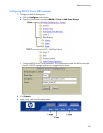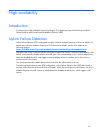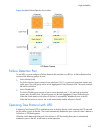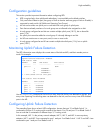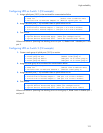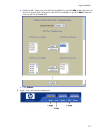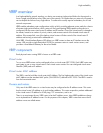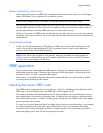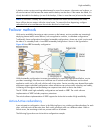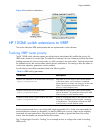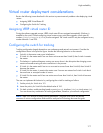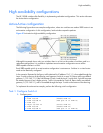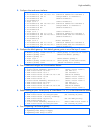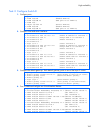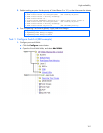
High availability
174
Master and backup virtual router
Within each virtual router, one VRRP router is selected to be the virtual router master. See “Selecting the
Master VRRP Router” for an explanation of the selection process.
NOTE: If the IP address owner is available, it will always become the virtual router master.
The virtual router master forwards packets sent to the virtual router. It also responds to Address Resolution
Protocol (ARP) requests sent to the virtual router's IP address. Finally, the virtual router master sends out
periodic advertisements to let other VRRP routers know it is alive and its priority.
Within a virtual router, the VRRP routers not selected to be the master are known as virtual router backups.
Should the virtual router master fail, one of the virtual router backups becomes the master and assumes its
responsibilities.
Virtual Interface Router
At Layer 3, a Virtual Interface Router (VIR) allows two VRRP routers to share an IP interface across the
routers. VIRs provide a single Destination IP (DIP) for upstream routers to reach various destination
networks, and provide a virtual default Gateway.
NOTE: Every VIR must be assigned to an IP interface, and every IP interface must be assigned to a
VLAN. If no port in a VLAN has link up, the IP interface of that VLAN is down, and if the IP interface
of a VIR is down, that VIR goes into INIT state.
VRRP operation
Only the virtual router master responds to ARP requests. Therefore, the upstream routers only forward
packets destined to the master. The master also responds to ICMP ping requests. The backup does not
forward any traffic, nor does it respond to ARP requests.
If the master is not available, the backup becomes the master and takes over responsibility for packet
forwarding and responding to ARP requests.
Selecting the master VRRP router
Each VRRP router is configured with a priority between 1 and 254. A bidding process determines which
VRRP router is or becomes the master—the VRRP router with the highest priority.
The master periodically sends advertisements to an IP multicast address. As long as the backups receive
these advertisements, they remain in the backup state. If a backup does not receive an advertisement for
three advertisement intervals, it initiates a bidding process to determine which VRRP router has the highest
priority and takes over as master.
If, at any time, a backup determines that it has higher priority than the current master does, it can preempt
the master and become the master itself, unless configured not to do so. In preemption, the backup
assumes the role of master and begins to send its own advertisements. The current master sees that the
backup has higher priority and will stop functioning as the master.



